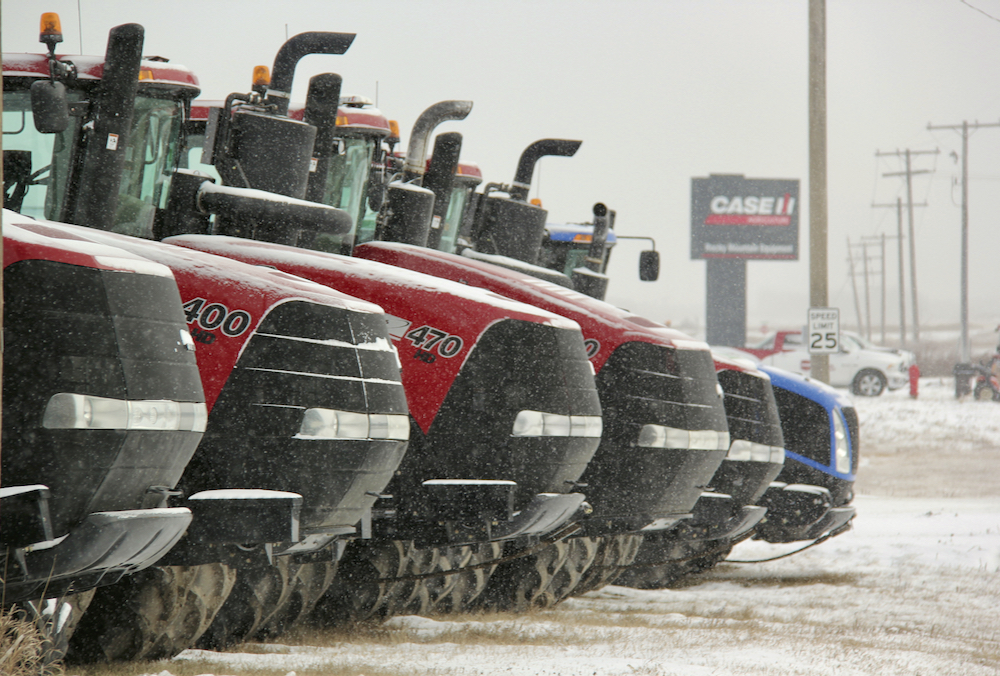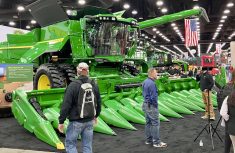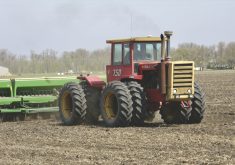This year, any farmer expecting a new tractor in time for spring seeding knows they shouldn’t hold their breath.
It may or may not arrive on time. Problems including staff shortages, transportation bottlenecks, a shortage of components — all a result of COVID-19 in one way or another — have hit ag equipment manufacturers simultaneously and hard.
It’s the main reality of today’s new farm equipment market, and it has pushed the used machinery market into unprecedented territory.
Read Also

The pros and cons of new technologies
New farm technology hitting the marketplace can be awfully enticing, and it’s not been unheard of in years gone by…
“Some of the lowest levels we’ve ever had,” John Schmeiser, CEO of the Western Equipment Dealers Association, says of used equipment inventories on dealer lots. “We have 70 per cent of our dealers saying their used equipment is too low. And we’ve also seen month-over-month price increases on used tractors and combines that are sitting around, primarily just because of the delay getting new equipment. We still have supply chain issues because of the pandemic.”
Used supply is low. Buyers still waiting for new machines are holding onto their trade-ins, reducing the stock of used equipment on the market. And demand is high. Many producers who would have looked at buying new machines have turned their attention to the used equipment market instead, simply in order to actually get something, anything, in time to do the job, which means more buyers are competing for fewer machines.

“Because customers are being advised that wait times for delivery of new are pretty bad or being pushed back, it’s kind of driving them to used equipment,” Schmeiser adds. “Especially right at harvest, there was a run on used combines.
“The most amazing stat I’m looking at is used combine pricing. Historically, the longer a combine sits on a dealer’s lot, the lower the price is going to be. That’s the industry norm. Every month over the past year dealers have been increasing pricing on used equipment, solely because of the demand that’s out there. This is unprecedented.
“I’ve been managing the association since 1996, and I’ve never seen such a prolonged period where month after month there’s a positive percentage increase in combine pricing.”
Most months until midsummer, dealers had reported a compounding one or two per cent monthly jump. Then monthly increases started to turn more sharply upward: three per cent in August, followed by five per cent in both September and October.
Four-wheel drive tractors saw even bigger month-to-month gains at dealerships throughout most of the year, but just like combines, price increases really took off in late summer, hitting six per cent per month in each of September and October.
Auctioneers Ritchie Bros. saw similar price growth trends at their sales throughout 2021.
“From January to the end of April, which includes a lot of our farm auctions early in the spring, there was almost a 10 per cent increase year over year,” says Jordan Clarke, sales director for Canada prairies division at Ritchie Bros. “The same in Q4, there was a nine per cent increase in pricing year over year. The low point of the year was June and July. Crop conditions were tough. Drought was a factor in a lot of parts of the Prairies. When we saw (commodity) prices increasing, that changed the aspect in demand from buyers. That was good to see, because as we went through July every sale was down from the week before.”
The outlook from a 2021 Agricultural Equipment Manufacturers (AEM) survey showed most machinery manufacturers expected their difficult conditions to persist long into 2022, some even expected it to continue into 2023. So will that continue to drive the unprecedented demand — and prices — for good, late-model used ag equipment through the next growing season?
Responds Schmeiser: “96 per cent of dealers are reporting that their new equipment inventories are too low.”
That means we can expect continued upward price pressure for used machines, depending, of course, on whether all factors influencing demand stay positive.
“There’s no magic to equipment sales (demand),” says Schmeiser. “It’s always three things. Number one is weather. Secondly, commodity prices. The third thing is interest rates. If all three of those things hit, demand for equipment is going to skyrocket.
“There was a drought on the prairie but the crop that was out there had good quality so it wasn’t as bad as it could have been, and those commodity prices were pretty strong.”
“Weather is a huge factor,” agrees Clarke. “But I am a little concerned about the rising costs of inputs, which could potentially affect equipment sales. If we can start the year off with a decent amount of snow and runoff and get the year started on the right foot, I think we’ll see a good start.”
So far, the winter precipitation levels look good in most places. And with interest rates still so low and with affordable financing, don’t expect to see bargains popping up at auction sales or on dealers’ lots as long as the growing season looks promising.
“I would think, honestly, it (the used equipment market) is going to mimic a lot of what we saw in the last half of 2021,” says Clarke. “From all the information we’ve seen, it’s going to take a while for manufacturers to catch up to demand. I honestly think there’s going to be strong demand on the supply that’s out there.
“So if there’s good used equipment available, whether on a dealer’s lot, a private sale or auction sale, I think there’s going to be a lot of buyers going after those pieces. We ended the year off with strong demand for equipment and all indications are we’re going to start the year on the same foot.”
On top of the problems at the manufacturers choking production capacity for new machines, industry watchers had expected a surge in new machinery sales starting around 2020 and carrying through the next few years. It’s part of the regular cycle of sales peaks and valleys the industry has experienced for decades. So supply chain difficulties have hit the brands at the worst possible time.
“We’re in that time in the cycle again where there’s customer demand,” says
Schmeiser. “I just got the new equipment sales stats for year-end 2021, and we’re up double-digit percentage increases in every category.
“The only downside is in November and December, compared to the previous year. We were down compared to the previous year just because of dealers’ inability to get (equipment) from the manufacturer. If they could get it, they could sell it. Some dealers look at it as a missed opportunity.”
Will those missed sales opportunities throttle back dealers’ profit?
“It may,” says Schmeiser. “But also keep in mind if a customer decides to hang on to their used equipment a little bit longer, that’s an opportunity for us on the parts and service side. We are seeing very busy shops and our parts supply situation today is a lot better than it was at the start of the pandemic.”
Timed auctions take over
COVID-19 has changed farm auctions, and this new method may stick
For anyone growing up in farm country, a farm auction was like a day at an amusement park. Get a hamburger, wander around looking at all the equipment, and maybe come home with something new. Sales were as much a social event for attendees as a business trip. Most of the local neighbours would be there.
That atmosphere has stayed the same up until recently, although over the years since then the total number of annual auctions has declined along with the thinning out of individual farmyards across the landscape. But like so many things, Covid-19 has forced a change in the way auction sales are conducted. Auctioneers have had to adapt to public health restrictions on gatherings.

“The format we use to conduct the sale has changed,” explains Jordan Clarke, sales director for Canada prairies division at Ritchie Bros Auctioneers. “It’s no longer a live auction sale with a live auctioneer, it’s through a timed auction format.”
While the new format was adopted to cope with Covid, however, Ritchie Bros. has found it surprisingly successful.
“We had to transition to that for Covid reasons,” Clarke continues. “It’s one of those things we weren’t too eager to try … but we had to. And instantly we saw quite a bit of success for sellers and ease of purchasing for buyers. It’s changed the way we do business. There’s a lot of efficiencies for both sides and for our company as well. We see now quite a bit of demand and appreciation for that format and it’s working quite well.”
Also, mostly unrelated to Covid, the number of different options available to farmers who want to dispose of or purchase machinery has grown. Among them is the increased use of general consignment sales at central locations.
“The consignment sales are growing in size,” says Clarke. “If people want to sell one or two pieces through an auction sale, this is the best option to do it. We provide as many options to our customers as we can.”
Despite giving sellers more choices, Clarke says the number of on-farm sales has remained relatively constant in the past decade; it’s just done differently now.
“The farm auction, although it’s changed in format is still alive and well,” he says. “Last year we did over 150 farm and off-site auctions and that’s very steady with the trend we’ve had over the last 10 years.”
Now, though, the move to a timed, online format, driven by necessity, may outlast the pandemic, at least for Ritchie Bros.
“From a seller’s perspective, I would 100 per cent advise our sellers to have a timed auction for their dispersal,” Clarke continues. “I grew up in the auction business. To watch the consignor be able to sit back and enjoy the day, watch the transactions and the items sell in an environment where they can truly be at peace with it is truly great to watch, as opposed to a live auction where you have 500 to 1,000 people in your yard. There’s a lot of moving parts and a lot of times the owners are needed and wrapped up in the action of the day. And a lot of times they miss out on what’s happening on sale day.
“From a buyer’s perspective, they can attend as many sales as they want in one day and bid on items or place maximum bids and let the system bid on their behalf. They can watch it from their tractor seat or the comfort of their shop. Prior to that, even with internet bidding, you still had to be at that computer screen or phone at the time that item was selling.”
Clarke adds that the new sales format has actually resulted in an increase in participation at the company’s sales, because of the new online method.
“So from our aspect, I think we’re going to proceed with timed auction sales for the foreseeable future, for at least 2022,” he says. “We’re always looking at changes we can make. There’s going to be certain times an auctioneer has merit. If a customer truly wants that, we’re willing to talk about what that looks like.
“We’re navigating our way through this, but we’ve caught the timed-auction bug and I think our customers have as well. It seems to be working.”
















